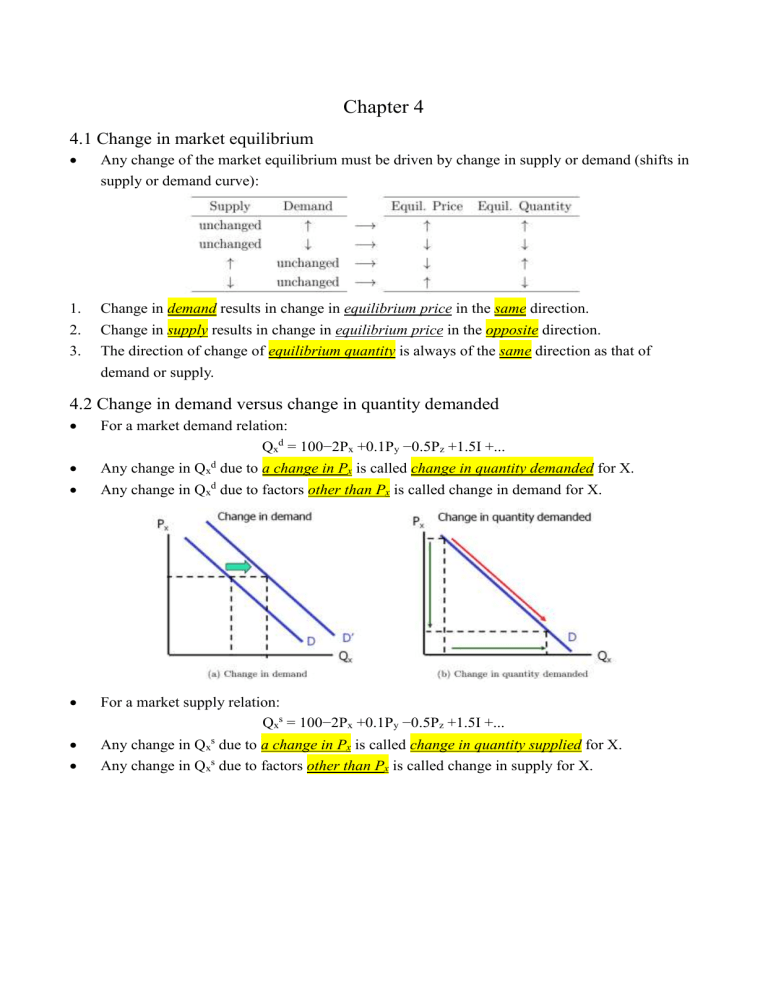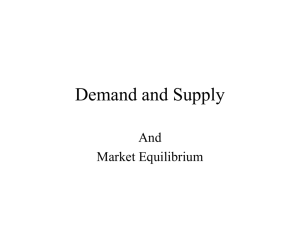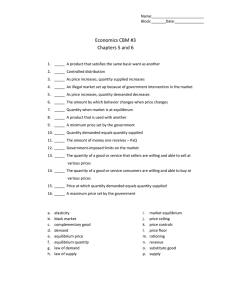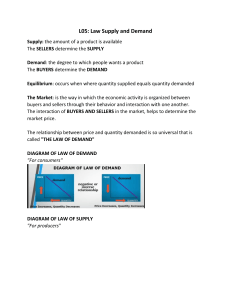
Chapter 4 4.1 Change in market equilibrium Any change of the market equilibrium must be driven by change in supply or demand (shifts in supply or demand curve): 1. Change in demand results in change in equilibrium price in the same direction. 2. 3. Change in supply results in change in equilibrium price in the opposite direction. The direction of change of equilibrium quantity is always of the same direction as that of demand or supply. 4.2 Change in demand versus change in quantity demanded For a market demand relation: Qxd = 100−2Px +0.1Py −0.5Pz +1.5I +... Any change in Qxd due to a change in Px is called change in quantity demanded for X. Any change in Qxd due to factors other than Px is called change in demand for X. For a market supply relation: Qxs = 100−2Px +0.1Py −0.5Pz +1.5I +... Any change in Qxs due to a change in Px is called change in quantity supplied for X. Any change in Qxs due to factors other than Px is called change in supply for X. 4.4 Factors affecting demand 1. 2. 3. There are 5 factors affecting the demand: Income Taste Price of substitutes and complements 4. 5. Population of potential buyers Expectations Income When an increase in income increases the demand of X, X is called normal good. When an increase in income decreases the demand of X, X is called inferior good. Taste Example: The release of Transformers (film) may induce taste for the Transformers toys. Price of substitutes and complements If X and Y are substitutes, an increase in the price of X decreases the quantity demanded for X and increases the demand for Y. If X and Y are complements, an increase in the price of X decreases the quantity demanded for X and decreases the demand for Y. Population of potential buyers Increase in the population of potential buyers increases the demand for X. Expectations When the consumers expect the price of a good to increase (cost increase) in the future, they will consume more today, or stock up. This increases the demand for the good today. When the consumers expect the price of a good to decrease (cost decrease) in the future, they will postpone the purchase. This decreases the demand for the good today. The impact of our expectation on future price tends to be bigger for durable goods as they can be stored. The impact of our expectation on future price tends to be smaller for perishable goods as they cannot be stored. 4.5 Factors affecting supply There are 5 factors affecting the supply: 1. Technology 2. 3. 4. 5. Factor price Changes in the price of goods that use the same input Population of potential suppliers Expectations Technology An advancement in technology reduces the cost of production and increases the supply. Factor price An increase in the factors prices increases the cost of production and decreases the supply. Gasoline, oil (or energy) is input to many industries. Their prices are factor prices for most industries. Changes in the price of goods that use the same input For 2 goods using the same input (i.e. A,B), if you do not use it to produce good A, you will use it to produce good B. If the price of good B increases, the opportunity cost of good A will increase. Hence, the supply of A decreases. Population of potential suppliers Increase in the population of potential suppliers increases the supply. Expectations When the suppliers expect the price of a good to increase (benefit increase) in the future, they will postpone the purchase. These decreases the supply for the good today. When the suppliers expect the price of a good to decrease (benefit decrease) in the future, they will sell more today. These increases the supply for the good today.




